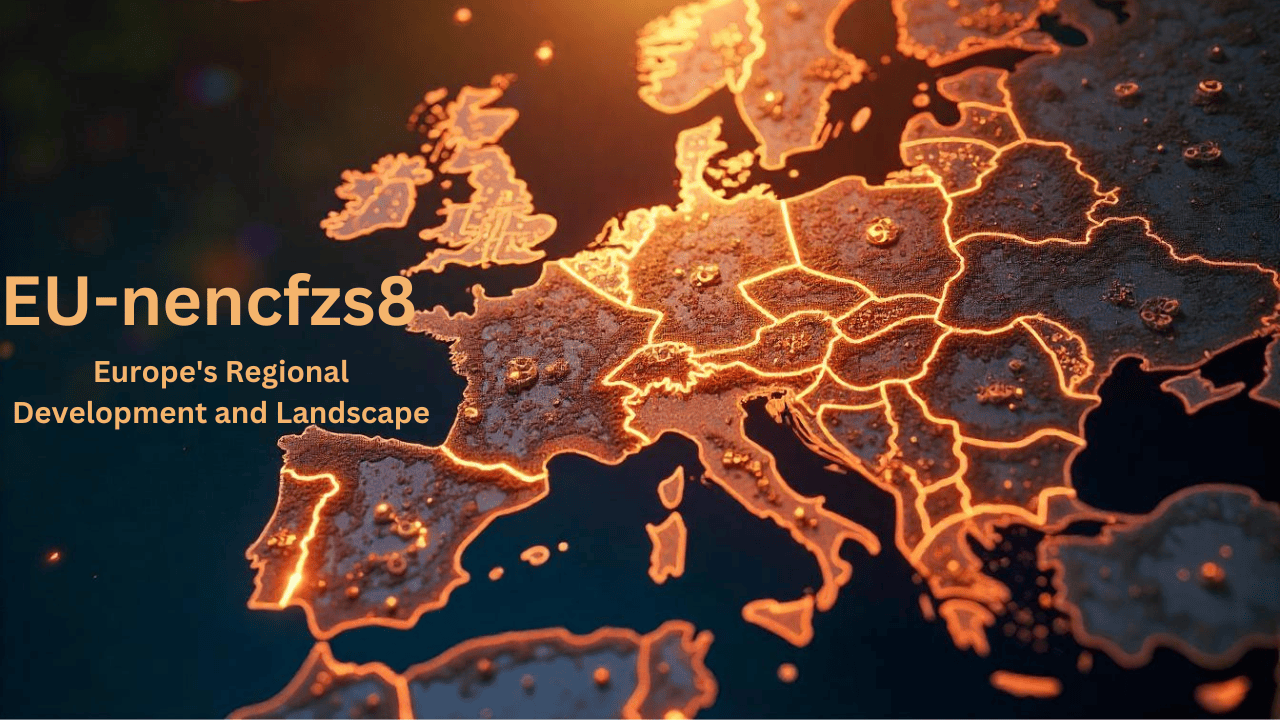In the quest for sustainable development, the European Union has consistently leveraged groundbreaking initiatives to achieve economic, environmental, and social progress. One of the significant frameworks contributing to this mission is Eu-nencfzs8. This strategic plan not only advances innovation but also strengthens regional cohesion and promotes sustainable practices across diverse sectors.
This article delves into the Eu-nencfzs8framework, its core objectives, pivotal benefits, and its profound impact on shaping the future of Europe.
What is Eu-nencfzs8?
At its core, Eu-nencfzs8 represents a comprehensive initiative designed to foster collaboration, innovation, and regional development across the EU. The framework integrates cutting-edge technology, sustainability principles, and regional support to address key challenges facing member states.
Developed under the broader EU regional and economic development policies, Eu-nencfzs8 primarily focuses on:
- Fostering regional innovation ecosystems.
- Promoting sustainable development and green energy transitions.
- Strengthening cross-border collaborations.
This approach ensures that each EU member state aligns with overarching goals while addressing its unique needs and challenges.
The Key Objectives of Eu-nencfzs8
Promoting Innovation and Technological Advancement
Eu-nencfzs8 emphasizes fostering innovation by providing financial and infrastructural support for emerging technologies. This includes investments in AI, renewable energy, and biotechnology, aimed at ensuring Europe remains globally competitive.
Strengthening Regional Cohesion
One of the framework’s critical pillars is reducing disparities between EU regions. Through targeted investments, Eu-nencfzs8 ensures equal opportunities for less-developed areas, thereby boosting their economic growth and integration.
Sustainability and Green Transition
As climate change remains a pressing global challenge, the framework prioritizes sustainability by promoting clean energy solutions, eco-friendly infrastructure, and policies aimed at achieving net-zero emissions.
Encouraging Cross-Border Collaboration
Recognizing the importance of collaboration, the framework facilitates partnerships between governments, businesses, and academic institutions across member states.
Eu-nencfzs8 and Regional Innovation Ecosystems
One of the standout achievements of Eu-nencfzs8 is its focus on regional innovation ecosystems. These ecosystems bridge the gap between research, industry, and policymakers, fostering a collaborative environment where innovation can thrive.
Key components include:
- Support for Startups and SMEs: Financial incentives and incubation programs.
- Research and Development Grants: Funding projects that align with the EU’s strategic goals.
- Digital Transformation: Empowering regions to adopt smart technologies.
Through these measures, the framework boosts regional economies and ensures alignment with global technological trends.
The Role of Eu-nencfzs8 in Climate Action
With sustainability at the forefront, Eu-nencfzs8 has committed substantial resources to combat climate change. The initiative aligns with the EU Green Deal, focusing on:
- Renewable energy projects, such as wind and solar farms.
- Developing green urban infrastructure.
- Incentivizing sustainable agriculture and forestry practices.
These measures not only mitigate environmental degradation but also create jobs in green sectors, contributing to long-term economic stability.
Benefits of Eu-nencfzs8 for Member States
Economic Growth and Stability
Through targeted funding, the framework accelerates regional development, creating jobs and boosting local economies.
Enhanced Research and Innovation
Eu-nencfzs8 provides a platform for collaborative research, ensuring the EU remains at the forefront of technological advancements.
Improved Quality of Life
By focusing on sustainability and regional cohesion, the framework enhances living standards for EU citizens, providing better infrastructure, cleaner environments, and more inclusive societies.
Resilience Against Global Challenges
With its forward-thinking approach, the initiative equips member states to tackle economic, environmental, and social challenges effectively.
Eu-nencfzs8 in Action: Success Stories
The Eu-nencfzs8 framework has achieved remarkable outcomes across various regions and sectors, exemplifying how a well-structured initiative can bring tangible benefits to member states. Through its strategic goals of innovation, regional development, and sustainability, EU-NENCFSZ8 has transformed communities and industries. Here are some success stories that highlight the impact of this visionary framework.
1. Baltic Clean Energy Transformation
The Baltic region, historically reliant on fossil fuels, has embraced renewable energy solutions thanks to funding and strategic guidance from Eu-nencfzs8. Investments in offshore wind farms along the coasts of Lithuania, Latvia, and Estonia have not only reduced greenhouse gas emissions but also created thousands of jobs in the green energy sector. Projects such as the Baltics Offshore Energy Grid exemplify how cross-border collaboration can lead to regional energy independence and sustainability.
Key Achievements:
- Reduction of carbon emissions by over 20% in participating countries.
- Establishment of regional energy interconnectivity for efficient power distribution.
- Creation of training programs for workers transitioning from fossil fuel industries to green jobs.
2. Digital Innovation Hubs in Southern Europe
Eu-nencfzs8 has empowered small and medium-sized enterprises (SMEs) in countries like Portugal, Spain, and Italy to embrace digital transformation. Through a network of digital innovation hubs, businesses have gained access to advanced technologies, such as artificial intelligence, blockchain, and the Internet of Things (IoT). This support has enhanced their competitiveness in global markets.
One standout example is the “Smart Agritech” project in Spain, which uses IoT to optimize irrigation and farming practices. This has led to increased agricultural yields while conserving water resources in drought-prone areas.
Key Achievements:
- Increased productivity by 30% in participating SMEs.
- Enhanced global export capabilities for technology-driven businesses.
- Strengthened local economies through digital literacy and job creation.
3. Green Urban Development in Scandinavia
Cities like Stockholm and Copenhagen have emerged as global leaders in sustainable urban development, thanks to EU-NENCFSZ8’s focus on green infrastructure. The integration of smart transportation systems, eco-friendly building practices, and urban rewilding projects has transformed these cities into models of livability and environmental responsibility.
Stockholm’s “Smart Mobility Hub” project, funded under the EU-NENCFSZ8 framework, has significantly reduced urban congestion and air pollution by encouraging the use of electric public transport and bike-sharing systems.
Key Achievements:
- Reduction in urban CO2 emissions by 25%.
- Improved public health outcomes due to cleaner air and increased physical activity.
- Recognition of Stockholm as one of the world’s greenest cities by the Global Sustainability Index.
4. Advancing Biomedical Innovation in Central Europe
In Central European countries like Poland and Hungary, Eu-nencfzs8 has facilitated collaborations between universities, biotech startups, and healthcare providers. This has led to groundbreaking advancements in medical research, particularly in gene therapy and personalized medicine.
One notable project, the “Precision Health Initiative,” has brought together experts from various fields to develop affordable genetic testing solutions for rare diseases. The initiative has not only improved healthcare access but also fostered new industries in the region.
Key Achievements:
- Introduction of cost-effective genetic testing kits to underserved populations.
- Growth of biotech clusters that attract international investment.
- Improved patient outcomes through early diagnosis and targeted treatments.
5. Renewable Energy Villages in Eastern Europe
Rural areas in Eastern Europe have benefited from the EU-NENCFSZ8 framework’s focus on renewable energy and energy efficiency. Initiatives like the “Energy-Smart Villages” program have equipped communities in Romania and Bulgaria with solar panels, energy storage systems, and microgrids, enabling them to become self-sufficient in energy production.
These projects have reduced energy poverty while setting a benchmark for sustainable rural development.
Key Achievements:
- Over 200 villages now operate on renewable energy.
- Reduction in energy costs for residents by 40%.
- Empowerment of local communities through participatory energy governance.
6. Cultural Heritage and Sustainable Tourism in the Mediterranean
In regions like Greece and Cyprus, EU-NENCFSZ8 has supported the preservation of cultural heritage sites while promoting sustainable tourism. Initiatives such as eco-tourism trails and green accommodations have revitalized local economies without compromising environmental integrity.
One example is the “Heritage for Tomorrow” project in Crete, which combines virtual reality tours of ancient sites with eco-friendly tourism infrastructure. This approach has attracted culturally conscious travelers and boosted the local economy.
Key Achievements:
- 50% increase in eco-tourism revenue in participating areas.
- Preservation of endangered cultural sites through sustainable funding.
- Enhanced global visibility of Mediterranean heritage.
These success stories underscore the transformative potential of EU-NENCFSZ8. By addressing region-specific challenges with innovative solutions and fostering collaboration across borders, the framework continues to set a benchmark for regional development and sustainability. It is a testament to the EU’s commitment to creating a more inclusive, resilient, and forward-thinking Europe.
Challenges and Criticisms of Eu-nencfzs8
While the framework has achieved significant milestones, it is not without its challenges:
- Uneven Implementation
Some regions face difficulties in accessing resources due to bureaucratic hurdles or lack of infrastructure. - Funding Constraints
Despite substantial investments, the demands for funding often exceed available resources, limiting the framework’s reach. - Resistance to Change
Cultural and political resistance in some regions can slow the adoption of innovative practices and policies.
Addressing these challenges requires ongoing evaluation, stakeholder engagement, and adaptive strategies.
Future Prospects of Eu-nencfzs8
Looking ahead, the EU-NENCFSZ8 framework has ambitious plans to deepen its impact, including:
- Expanding green energy projects to achieve carbon neutrality by 2050.
- Strengthening digital infrastructure to foster a more connected and competitive Europe.
- Enhancing collaboration with global partners to address shared challenges.
These prospects promise a brighter future for Europe, underpinned by innovation, sustainability, and unity.
Conclusion
Eu-nencfzs8 represents a transformative framework for the European Union, driving innovation, regional development, and sustainability. By addressing challenges and leveraging opportunities, the initiative lays the foundation for a prosperous, resilient, and inclusive Europe. Through continued collaboration and investment, EU-NENCFSZ8 promises to shape a future where innovation and sustainability go hand in hand, ensuring long-term benefits for all.
FAQs
What is the main goal of Eu-nencfzs8?
Eu-nencfzs8 aims to foster innovation, regional cohesion, and sustainable development across the European Union, ensuring balanced growth and global competitiveness.
How does EU-NENCFSZ8 support innovation?
The framework provides funding, infrastructure, and collaborative platforms for startups, SMEs, and research institutions, promoting cutting-edge technological advancements.
What role does sustainability play in EU-NENCFSZ8?
Sustainability is central to the initiative, with significant investments in renewable energy, green urban infrastructure, and eco-friendly practices aligned with the EU Green Deal.
What are the challenges faced by EU-NENCFSZ8?
Challenges include uneven implementation, funding constraints, and resistance to change in certain regions, requiring adaptive strategies for effective resolution.
How does EU-NENCFSZ8 impact citizens’ lives?
The initiative improves living standards by creating jobs, enhancing infrastructure, and fostering inclusive, sustainable communities across the EU.
What is the future vision of EU-NENCFSZ8?
Future plans include expanding green energy projects, strengthening digital connectivity, and enhancing global partnerships to address emerging challenges.










